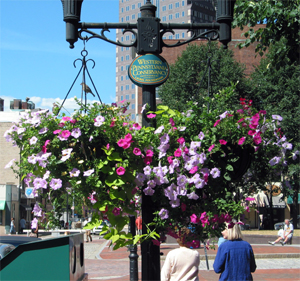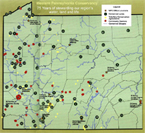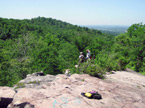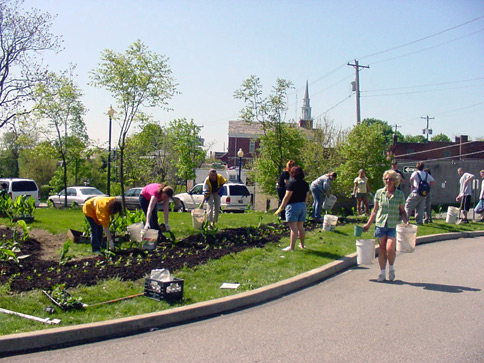|
Conserve |
|
| Conserve 75th Anniversary Commemorative Issue |
| 1930s - 40s |
| 1950s |
| 1960s |
| 1970s |
| 1980s |
| 1990s |
| 2000s |
| Fall 2007 Home |
| Past Issues |
White Rocks
In July 2007, the Western Pennsylvania Conservancy acquired
the 875-acre property in Georges Township, Fayette County known locally as "White Rocks" for the large bleached sandstone outcrop that distinguishes the north face of the site. The land is now open for public enjoyment and offers pristine beauty, rare species, wide trails and an interesting past. WPC transferred the property to the state Department of Conservation and
|
2000s
Protecting Western Pennsylvania’s Water When the Western Pennsylvania Conservancy launched the Watershed Assistance Center in 2001, the organization understood the need to engage and support local communities, primarily through grassroots conservation groups, if it were to have true success in improving local conservation practices. In 2006, the Watershed Assistance Center changed its name to the Freshwater Conservation Program to more accurately reflect WPC's mission, and began positioning staff to work, and often live, in key watershed communities. This shift of staff is occurring to help the organization implement freshwater conservation protection and restoration projects that best represent the needs and issues of local watershed conservation. Western Pennsylvania has some of the most biodiverse, globally significant freshwater resources in the world. WPC will continue protecting these areas while working to improve watersheds that, with a little work, could flow as they did more than a hundred years ago. Although the Freshwater Conservation Program will be working at the local level to protect and restore important conservation targets, one eye will always be focused on the bigger picture of watershed conservation in the region.
|
Community Gardens Continue to Flourish Through Ongoing Partnerships and Volunteers
Although the Western Pennsylvania Conservancy began planting community flower beds in 1978, it is worth noting that one of the organization's earliest projects employed landscaping as the tool of choice to stabilize a city hillside in 1940. Today, 140 community gardens beautify 19 western Pennsylvania counties through the efforts of more than 4,000 local residents and 29 corporate sponsors. The Community Gardens and Greenspace Program volunteers donate more than 20,000 hours per year to create gardens that celebrate the region’s beautiful landscape and enhance its quality of life. More than half of these volunteers are children and youth, an indication of the long-range viability of the program. WPC’s community gardens have become a signature feature of the western Pennsylvania landscape. Appearing in varied locations with many different configurations, the gardens provide a backdrop and enhancement for other cultural and civic assets. The Pennsylvania Department of Transportation estimates that more than 3 million people per day see the results this volunteer effort. View a slideshow of our garden volunteers at work and see the fruits of their labor.>
|
 400 Hanging Baskets
400 Hanging Baskets Thanks to the Laurel Foundation of Pittsburgh, more than 400 lush hanging floral baskets beautified downtown Pittsburgh again this year. In 2005, the popular program faced elimination because of lack of funding. The Laurel Foundation
saved the program by providing full funding and has generously continued to fund the program.
The Foundation, established in 1951 by Cordelia S. May, has funded various Western Pennsylvania Conservancy community greening projects since 1987 and other aspects of WPC work since 1970, but did so anonymously at Mrs. May's insistence until she passed away in 2005.
2001 WPC launched its Watershed Assistance Center to serve as a resource for grassroots conservation groups and improve the quality of our watersheds.
In 2006, it was renamed the Freshwater Conservation Program to more accurately reflect its expanding protection and restoration projects.
WPC partners to protect a 191-acre farm in Elk County that is home to elk during bugling season.
2002 The six-year Fallingwater Restoration Project is completed and final shoring is removed.
2004 On June 4, WPC transferred 540 acres of Lake Erie shoreline property to the state and Erie Bluffs State Park was created.
Completed renovations of the Kaufmanns’ former dairy barn now called “The Barn at Fallingwater.” The building has new life as an interpretative and educational
facility.
2005 Dennis McGrath named WPC’s president and CEO. He led a strategic planning process that advances our mission.

2006 WPC opened the Allegheny Project Office in Ridgway, Elk County to work closely with private landowners in Pa’s hardwood region and provide expert
ecological service to local communities. Today, WPC has offices throughout western Pennsylvania.
2007 Thomas D. Saunders named WPC president and CEO.





